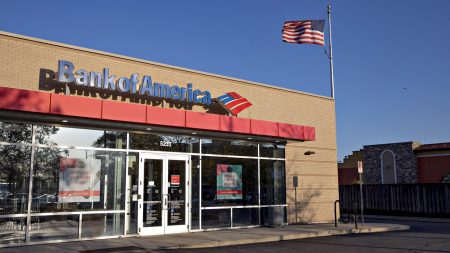Key takeaways
- The Federal Reserve held its federal funds rate steady last week, marking the third straight meeting the rate has remained unchanged.
- The Fed’s rate pause could mean stability for high-yield savings account APYs.
- The top-yielding savings account rate holds steady this week at 4.40 percent APY, available from Openbank.
The Federal Reserve continued its wait-and-see approach to managing the U.S. economy last week by holding its key interest rate steady, with Fed Chair Jerome Powell citing a “solid” economy that nevertheless could start to suffer due to tariffs from the White House. For now, the Fed is in a holding pattern that has placed the American people’s money in limbo. Fortunately, it’s benefiting savers.
Why? Because an unchanged federal funds rate could prompt some banks to keep their annual percentage yields (APYs) high, in some cases well above 4 percent APY. In fact, such elevated rates on high-yield savings accounts have been beating the rate of inflation for more than two years now. Currently, you can earn up to 4.40 percent APY, from among the 120 banks monitored by Bankrate’s editorial staff.
As a banking reporter, I’ve interviewed various experts over the years who say the primary benefit of a federally insured savings account is that it provides a safe place for easy access to your emergency fund. That said, the historically high APYs on many accounts these days are an added bonus often worth seeking out.
— Karen Bennett, Senior Consumer Banking Reporter | Bankrate
What are today’s best savings accounts and rates?
It’s not difficult right now to find APYs above 4 percent on high-yield savings accounts, money market accounts and certificates of deposit (CDs). Currently, the top savings account rate is 4.40 percent APY, and it’s offered by Openbank, with a minimum opening deposit of $500. Launched in October 2024, Openbank is the digital arm of Santander Bank.
The current top APYs are as follows:
Note: Annual percentage yields (APYs) shown were updated between May 5 and May 11. All other information is current as of May 12. Bankrate’s editorial team validates this information regularly, typically biweekly. APYs may have changed since they were last updated and may vary by region for some products. Bankrate includes only FDIC banks or NCUA credit unions in its editorial listings.
What does the Fed’s holding pattern mean for high-yield savings accounts?
Many banks react to Fed interest rate moves by increasing their APYs when the Fed hikes rates, or they lower APYs when the Fed cuts rates. Because the Fed has kept its benchmark federal fund rate steady at a range of 4.25-4.5 percent in 2025, savers are likely to see continued stability in APYs, at least until the next Fed meeting on June 17-18.
How long the Fed will maintain its current holding pattern is uncertain, and officials could adjust rates in the future based on macroeconomic conditions. The Trump administration’s tariffs could spur “a rise in inflation, a slowdown in economic growth, and an increase in unemployment,” Powell said at a press conference last week.
While rates are unchanged for now, most economists are projecting Fed decreases later this year. However, depending on how macroeconomic conditions change, rates could go down further or faster than currently predicted, or they could actually even increase later this year.
— Adam Stockton, Head of retail deposits and lending at Curinos
Whether rates change or remain stable, savers should make decisions based on their own unique situations. “Broadly, consumers should think less about predicting or timing the market and more about what will meet their needs today,” Stockton says. “It is also important to revisit your goals regularly and make sure that your banking still meets your needs.”
Are there savings accounts that earn above a 5 percent APY?
While no widely available savings account monitored by Bankrate’s editorial staff earns an APY above 5 percent, there are some financial institutions — often credit unions — that offer such APYs. These are commonly promotional offers that earn a higher APY on a limited portion of your balance. What’s more, membership in many credit unions is limited to those who live or work in select geographical areas and/or professions.
Here are some examples of savings accounts with APYs of 5 percent or higher, effective as of May 12:
- Community Financial Credit Union: The High Yield Savings account earns a 10 percent APY on your first $1,000. Balances over that amount earn 0.10 percent APY. Those eligible for membership in the credit union include anyone who resides, works or attends school in the state of Michigan.
- Apple Bank: The SmartStart Savings account is open to New York or New Jersey residents aged six through 25, and it earns 6 percent APY on balances from $1.01 to $10,000. Higher balances of up to $20,000 earn an APY between 3.38 percent and 6 percent.
- BECU (Boeing Employees’ Credit Union): BECU’s Member Advantage Savings account earns 5.64 percent APY on the first $500 of your balance. BECU Membership is open to those who live, work, worship or attend school in Washington. Those who live in select counties in Oregon or Idaho are also eligible, as well as members of partner associations.
While they’re all offered by federally insured deposit institutions, some of the savings accounts listed above aren’t from banks or credit unions that Bankrate regularly monitors. However, they’re all from federally insured institutions. When opening a deposit account, it’s important to make sure it’s covered by federal deposit insurance.
What is the top APY available on a high-yield savings account?
Is a high-yield savings account with a 10 percent APY too good to be true? Actually, the question you should ask yourself is, “How do I qualify for such a rate?” Bankrate monitors deposit accounts at federally insured banks and credit unions for which consumers across the U.S. can easily qualify for advertised APYs. If you see a deposit account offering an APY of more than 4.5 percent, beware of any restrictions or limitations, such as:
- Is the APY a promotional rate? If so, how long will it last, and will my APY go down after the promotional period?
- Is the high APY available at a members-only credit union? If so, can you qualify for membership? Some credit unions that offer substantially higher APYs have firm membership requirements that limit customers to specific areas of the country (i.e. states, counties) and/or by profession or community organizations.
- Is there a balance threshold to qualify? Some savings accounts offer significantly higher APYs, but they’re for accounts with a high balance threshold that most consumers may not qualify for.
Bottom line
The Fed continues to keep rates unchanged despite political pressure to lower them. If you have money in a high-yield savings account, you’re benefiting from the Fed’s holding pattern through an APY that may remain elevated for longer. However, if your current savings account is earning a lackluster yield, it’s still a good time to find an account that helps you earn more in interest.
Read the full article here









